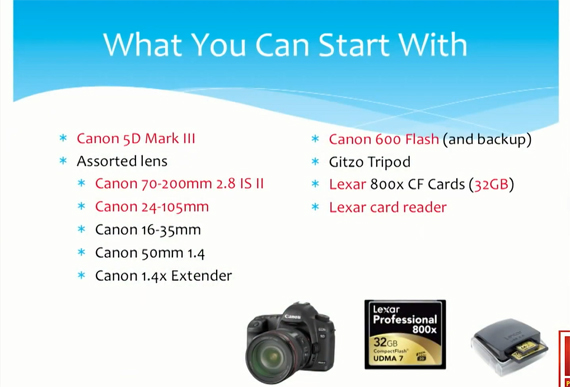The professional photography industry can be a scary place for the new photographer trying to earn a living doing what he or she loves by establishing a photography business. The competition is fierce, the bookkeeping seems mountainous, and for those introverts among us, the thought of interacting so closely with people for a living—um… promote myself?—is daunting to say the least.
But if deep passion for the craft is the driving force, one would be remiss not to try.
In this lecture, photographer Jeff Cable provides 15 tips for starting and maintaining a successful photography business, advice born in the crucible of experience as a professional photographer:
1. Have passion and LOVE what you do.
There’s nothing worse than hating one’s job. Professional photography requires hard work and long hours on the clock (and on one’s feet), so only the passionate photographers actually succeed at maintaining successful photography businesses without burning out—and sometimes even they fail.
Passion for the craft is what will sustain you when the going gets tough, but passion will also pay off in the everyday mundane routine, in relationships with clients, and in your photographs because it will push you to give your all.
“If you have passion and you’re having a good time, guess what you get back? You get photos of people who are also having a good time,” Cable said. “[Clients] tend to feed off of you having fun… I get hired a lot because of my photography, but I also get hired a lot because of who I am as a person.”

Cable walked a good distance to 5Pointz in Queens, NY just because he heard that the graffiti was cool. Then, he climbed onto a dumpster to photograph the rap battle taking place there. “Why did I do all of this? Is it because I’m getting paid? Am I going to send it to the newspaper? No, I’m doing this because I love photography,” he said.
2. Know how to shoot and practice if you don’t.
A successful professional photographer knows his or her equipment in and out and knows how to shoot in every lighting situation he or she might encounter on the job—but it’s not just about gear and lighting. The ideal pro can seamlessly select good foregrounds and backgrounds for stellar composition and can even predict situations and key moments before they happen so as to catch them with the shutter.
“If you’re going to call yourself a professional photographer and start commanding good money for it, you want to know how to do these things,” Cable said. “A good photographer can walk into any room or environment and within 15 seconds or less have it figured out, and that comes with experience… It’s not hard. It’s just practice.”
3. Focus on what you know.
As you build reputation and expertise as a professional photographer, make note of your strengths and weaknesses so that you can shoot according to your strengths for paying clients and practice on your own time or during free test shoots to improve your weaknesses.

Cable practiced shooting water polo for 1.5 years to prepare to shoot the US Water Polo team at the 2012 Olympics. He learned water polo in and out so that he could predict plays and know how to best tell the story.
4. Invest in good starter equipment.
Since price really does determine quality in photography, starting a successful photography business usually involves investing a good-sized wad of cash right from the get-go to purchase some high quality gear and backup gear—although renting backup gear is a viable option as well. Don’t forget that photography is all about the brain and eye and heart behind the camera, but do remember that, while you don’t need to buy the best quality glass or DSLR to take good photographs, it certainly helps if you can.
“The camera is just a tool, but it is an important one,” Cable said. “Having a good camera helps, but it doesn’t make you a good photographer… it won’t get you there all the way.”

Using his equipment spread as a reference point, Cable created this list of ideal Canon starter gear for beginner pros.
5. Get insurance and backup religiously.
Insuring your gear and property is obvious here, but purchasing general liability insurance, which protects you from liability if you bump into an expensive vase while shooting a wedding, or if a kid trips over your camera bag and breaks his arm, is just as important. Many venues even require proof of insurance before they will let you shoot there.
Along that same vein is a different kind of insurance: backups.
“If you don’t care about your photos, then don’t worry about it, but if you care about what you’re shooting or you’re charging a client for it, backup. And don’t just backup on your home machine. Backup somewhere else,” said Cable. “I’m really kind of very detail-oriented when it comes to that and you need to be if you’re charging people money.”
6. Differentiate yourself.
How do you stand out in a highly-competitive field like photography? You find ways to differentiate yourself from the rest by owning your unique style and by developing a Unique Selling Proposition (e.g. I work my butt off; I tell stories in ways that no one else can tell them, etc).
“There’s a lot of people out there that want to become photographers,” Cable said. “I’ll shoot stuff that most people wouldn’t shoot in ways that most people wouldn’t shoot it. I’ll lay on the ground, I’ll go up high, I’ll even dance sometimes with the kids while I’m shooting them.”
7. Have the right attitude.
People skills are a huge part of professional photography, so learn to treat clients with respect, of course—but more than that, learn to have fun, keep in touch, and put your clients at ease during photoshoots.
“Turn the camera around and show [your clients] what you’re getting,” Cable said. “If they’re hesitant, as soon as you turn the camera around and show them what you’re getting and it’s good, they’ll relax and then you’ll have that trust, and then you’re good.”

“Be a part of the event when you can,” said Cable, pictured here. “There’s nothing better than getting them to trust you than just by turning around and going, ‘Check this one out.'”
8. Have a compelling website.
Maintaining a fast, HTML-based website with a handful of solid images will work wonders for your business. In your portfolio and/or homepage slider, make sure to feature only your best 5-10 images; including one or two sub-par images just for the sake of having more can drive potential clients away.
“What are you judged by—your best images or your worst images? Your worst,” Cable said. “People will judge you on your website.”
9. Learn to tell the story.
No matter what the gig is, capture the key moments that you’re expected to capture while also keeping alert with your head on the swivel, looking for “unscripted” moments to fill in the holes in the story between those stereotypical key moments.
“Don’t wear blinders. Shoot a lot of things and look around for those unscripted moments that you didn’t expect,” said Cable. “You gotta be ready for anything that might happen.”

Cable captured this shot at the 2010 Winter Olympics because he was ready for it, having planned it out beforehand and thoroughly studied the key moments of the event.
10. Continue to learn.
Learning goes hand in hand with practice and differentiating yourself from your competition. Push yourself to try different techniques and equipment. Shoot in unfamiliar environments to figure them out. Go on photo walks for inspiration and do everything you can to stay interested and passionate.
“I dread the day when I can say, ‘I’ve done it all. I’ve learned every bit of the camera, I’ve shot everything I want to shoot,'” Cable said. “I push myself always to deliver better for the client, but also to kind of inspire me more.”
11. Understand people.
It may be easier said than done, but learning to understand people goes a long way in photography. Try to understand your clients, each one, and know who they are and what they like—your clients will appreciate the attention and your photographs will show your compassion.

“We forget as photographers that we can give this gift,” Cable said.
12. Design your pricing and stick to it.
If you’re just starting out as a professional photographer, it might be a good idea to do a few shoots for free while you build a decent portfolio, but as soon as you have that, Cable says, stop giving your art away. Develop a reasonable pricing and deliverables list according to your financial needs and don’t waver or undercut yourself, even when potential clients request lower rates.
“Your photos are your art,” Cable said. “Giving them away is leaving money on the table and is devaluing what you do. It makes you the guy with the camera just hitting a button.”
13. Know business as much as you know photography.
The sad fact is that many good and passionate photographers fail as professional photographers. Probably the number one reason for that is that having good photography sense isn’t enough; pro photographers also need to have just as much business sense—and this is where many go wrong, in Cable’s opinion. In fact, he even suggests going to school for business and learning photography on the side, instead of the other way around.
“The problem is, a lot of it is marketing and selling yourself and understanding the business side,” Cable said. “It’s great that you can take a good picture, but if you don’t know how to sell it and price it and you give it away, you won’t be able to do this for very long.”

In addition to embracing social media, working with local vendors is important. “They can be great referrals for you,” Cable said. “Those guys, they get asked.” Photographing vendors is a great way to earn their loyalty.
14. Always think about referrals.
Treat everyone—yes, Cable really means everyone, even the kids—as potential clients. Make friends, maintain a fun-loving and positive attitude, and work diligently at all times, even when your current paying client isn’t around. Always over-deliver.
“Whether it’s a referral from the family [or] the friends of the family, people spend a lot of money on advertising and word of mouth has always been and will be the best ever,” Cable said. “I go above and beyond to make an impression.”
15. Be smart about your time.
That old saying, “Time is money,” really is true. Unfortunately, the other saying that “things always take more time than you think they will” is also true. Effectively budget your time, always work towards streamlining your workflow, and make sure to factor time into your pricing.
Cable firmly believes that these 15 tips, which he attributes to his own success, will help your new or soon-to-be photography business not only to succeed, but also to thrive in the photography industry. After all, Cable began is career humbly by shooting occasional Bar and Bat Mitzvahs and making amateur mistakes like bringing only one 4GB memory card for the whole event.
Now, Cable is widely-respected as an Olympic photographer and he conducts photography lectures all over the world. If he can do it, you can too.
Like This Article?
Don't Miss The Next One!
Join over 100,000 photographers of all experience levels who receive our free photography tips and articles to stay current:






I find it helpful that you shared how a photographer can start their business by investing in a Canon 5D Mark III with several lenses and CF cards. Aside from that, they should also sign up with an insurance policy before opening one’s services to the public. Doing this will help a person recover their equipment in case it gets destroyed or damaged in the future while on a client request.
I liked that you pointed out that it would be smart to have an understanding of people. It might also be smart to really understand kids, especially if you are doing studio photography. It always seems like little kids don’t want to sit still and look at a camera when they are in a studio. So, figuring out how to keep their attention seems smart.
It sure helped when you suggested preparing a good amount of cash when starting the photography business because when it comes to its gears, the higher the quality, the more expensive it is. That is actually the reason why I am planning to hire a photography studio and photographer for the company’s ad. We do not have enough money to invest in photography gears because we are a startup company and will prefer spending on equipment that is really necessary for us.
Nice article on business growth i liked it and i feel its very useful for me. i need more suggestions